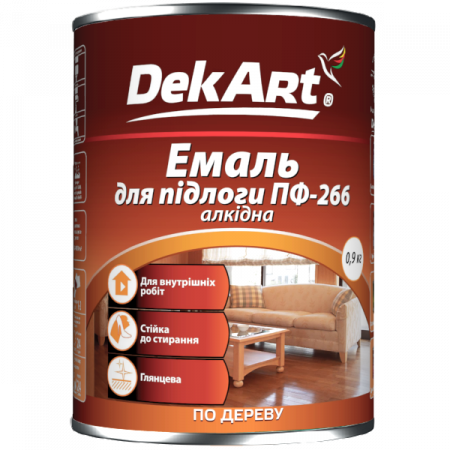
DekArt
Alkyd floor enamel PP-266
Specification
- It creates an even homogeneous and glossy coating.
- It provides adhesion with a coated surface.
- It is resistant to wear and domestic detergents.
Sphere of application
Alkyd floor enamel PP-266 is intended for the coating of previously coated or prepared uncoated wooden floors and other wooden and concrete surfaces located indoors.
Content
Technical data
| Consumption standard of 1 layer | 120-180 g/m2, depending on the type of surface and way of application. |
| Solvent | solvent TM DekART, 10% maximum of the total enamel weight. |
| Application | Apply with a brush, a roller or a spraying gun. |
| Drying period (23 °С, 50% RH) | 24 hours. Drying period increases if the temperature is getting down and relative air humidity is getting higher. |
| Solids content (DSTU ISO 3251) |
> 60 % |
| Density (DSTU ISO 2811-1) | 1,42±0,02 g/cm3 |
| Gloss (DSTU ISO 2813) | > 60 GU (at 60º) |
| Hardness (DSTU ISO 1522) | > 25 sec, Konig pendulum. |
| Non-volatile matter by volume (DSTU ISO 3233) |
54±2 % |
| VOC content (ISO 11890) | 290±10 g/l |
| Warranty period | 18 months from the date of manufacturing. |
| Packaging | 0,9 kg, 2,8 kg (1,8 kg, 2,6 kg, 25 kg, 50 kg - if pre- ordered) |
Gloss
Color


Application instruction
-
1. Surface preparation
The surface shall be dry (maximum humidity is 20%). Clean thoroughly of dirt, grease, dust, blue stain, decay. Clean thoroughly the surface from old loose coatings (loose paint and varnish) in mechanical (a scraper, a wire brush), thermal (hot air fan, infrared radiation) or chemical way (paint removal solutions). Chalk and lime-chalk coatings shall be removed mechanically till hard surface. It is not recommended to clean the surface by methods, which can damage wood fibers (for example, sandblast apparatus). Defected surfaces (holes, rends, cracks) shall be filled with Putty for wood ТМ Farbex. Puttied surfaces shall be sandpapered with small-grained paper till smooth, then remove the dust.
2. Priming
Previously treated wooden surfaces do not need any undercoating.
Previously non-treated wooden surfaces shall be primed with alkyd wood protective primer TM Maxima. Make sure that the surface is clean and dry before applying of primer.
Previously non-treated concrete surfaces shall be primed with the solution of enamel and solvent at a rate of 1:1.
3. Application
The enamel shall be thoroughly stirred till homogeneous conditions. The enamel is ready to use. Dilute enamel till working viscosity, if necessary. It is recommended to use the product of one batch applying the finishing layer on the surface to avoid deviation in color shades. If you use products of different batches it is necessary to mix them. The enamel shall be applied evenly with a brush, a roller or a spraying gun in 1-2 thin layers. Each next layer shall be applied in 24 hours. Application is performed at the temperature from + 10°С till + 35 °С and relative air humidity no more than 80%. The final hardening of the surface and the acquisition of its properties occurs 14 days after the coating.
4. Tool cleaning
Clean tools with a solvent and then with warm water with detergents if necessary.
Alkyd Floor Enamel DekArt
Одним із видів лакофарбових матеріалів є емаль ПФ-266, яка застосовується для фарбування дерев’яних та мінеральних підлог. Завдяки своїм технічним характеристикам емаль алкідна ПФ-266 утворює покриття з високою міцністю та еластичністю, яке витримує експлуатаційні навантаження, зберігаючи стійкий блиск та насиченість кольорів. Така емаль стійка до впливу води та миючих засобів, а також утворює однорідну та гладку глянцеву поверхню. Емаль алкідна для підлоги в нашому асортименті має різний час висихання: 8 годин та 24 години. Основними кольорами алкідної емалі є :- червоно-коричневий;
- золотаво-коричневий;
- жовто-коричневий.
повністю
Flow calculator
Consumption standard of 1 layer
When calculating the area to be painted, you need to subtract the area that will not be painted. (windows, doors, etc.)
Paint consumption may vary depending on dilution and uniformity of application of the paint.